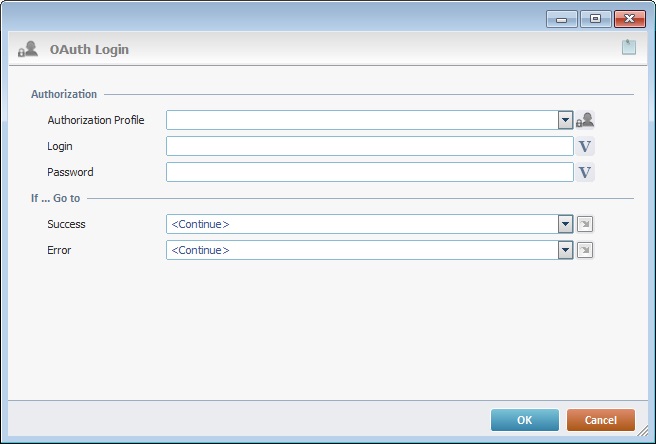Working with the Login Process
Process Purpose
The "Login" process triggers the OAuth 2.0 authentication by launching a web browser (grant type "Authorization Code"). The device operator fills in the credentials that are validated by the Identity Server. The device’s MCL-Client manages the retrieving of the Authorization Code and Access Token (or the Access Token directly for the grant types "Password" or "Client Credentials").
When you add a process, you are required to define its settings. This occurs in the process's properties window which is displayed automatically after having added the "Login" process.
If any subsequent edition is required, double-click the process to open its properties window and enter the necessary modifications.

Fill in the following options:
Authorization |
|
Authorization Profile |
Select an authorization profile from the drop-down OR click See To Create an Authorization Profile with "OAuth 2.0" Authentication and/or To Edit an Authorization Profile. |
Login |
These options are enabled by default, but it if you select an authorization profile with an "Authorization Code" or "Client Credentials" grant type, they are disabled/hidden. They ONLY apply to authorization profiles with a "Password" grant type.
Enter the login and password into the corresponding field OR click |
Password |
Enter the password or click |
If ... Go to |
|
Success |
Select a target location from the drop-down or click
|
Error |
Select a target location from the drop-down or click
|
Detail of a ![]() window:
window:

"S:Menu" is a screen included in the same program as the process.
"R:Routine_1" is a routine included in the same program as the process.
If required, use the ![]() icon on the upper right corner of the properties window to attach any relevant notes to this process. Click it and enter your notes in the resulting text box. These notes will be displayed in the corresponding "Actions" tab or "Process" window (in the "Notes" field) and in the "Developer Report".
icon on the upper right corner of the properties window to attach any relevant notes to this process. Click it and enter your notes in the resulting text box. These notes will be displayed in the corresponding "Actions" tab or "Process" window (in the "Notes" field) and in the "Developer Report".
After filling in the required options, click ![]() to conclude or
to conclude or ![]() to abort the operation.
to abort the operation.
The added process is displayed in the corresponding "Actions" tab or "Process" window.
![]() If you want to use a label as a target destination, you can use the "Auto-Label" mechanism. This alternative to the "Set Label" process allows you to create a label in the properties window of a process - specifically, in the fields used to define target destinations (ex: the "If Error..." type fields). See To Automatically Create a Label.
If you want to use a label as a target destination, you can use the "Auto-Label" mechanism. This alternative to the "Set Label" process allows you to create a label in the properties window of a process - specifically, in the fields used to define target destinations (ex: the "If Error..." type fields). See To Automatically Create a Label.
![]()
Use the right click in MCL-Designer's input boxes to access certain features regarding the input box's option as well as general actions such as "Copy"; "Paste"; "Search".
Ex: If you right-click the "Variable" input box (included in a "Conversion's" properties window), you are provided with the "Search..."and "Variable Select" options.
If you right-click another input box, it will provide other possibilities.
